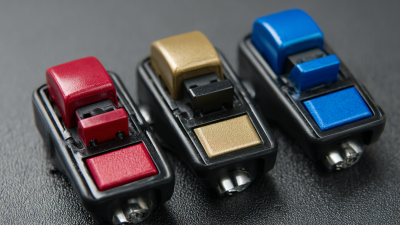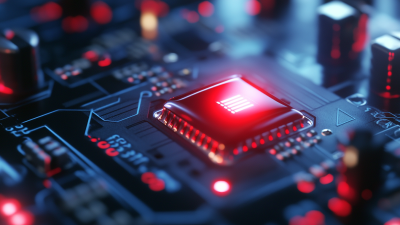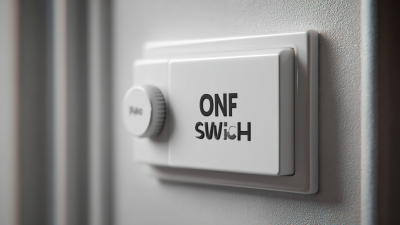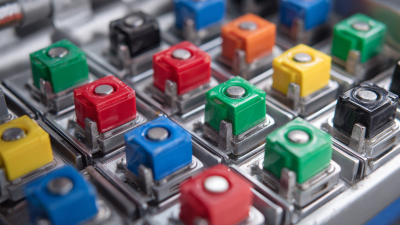The Rise of Push On Off Switch Technology in Smart Home Automation Systems
In recent years, the landscape of smart home automation has undergone a significant transformation, largely fueled by advancements in technologies that enhance user convenience and energy efficiency. Among these innovations, the "Push On Off Switch" has emerged as a pivotal feature, enabling homeowners to control their appliances seamlessly with just a simple push. According to industry expert Dr. Emily Carter, “The evolution of Push On Off Switch technology stands at the forefront of making smart homes more accessible and user-friendly.”
This breakthrough technology not only simplifies the user experience but also integrates smoothly with various smart home ecosystems, allowing for the effortless transition between settings and modes. The versatility of the Push On Off Switch has garnered attention from both manufacturers and consumers, solidifying its place as a cornerstone in modern home automation. As we explore the top five benefits and trends surrounding Push On Off Switch technology, it becomes clear that this innovation is not just enhancing convenience, but also contributing to a more energy-efficient and sustainable living environment.
By examining the rise of Push On Off Switches in smart home systems, we can better understand their impact on daily life and their potential to shape the future of home automation. With the increasing demand for smarter living solutions, the Push On Off Switch is set to revolutionize how we interact with our living spaces, making them more intuitive and responsive to our needs.

The Evolution of Push On Off Switch Technology in Home Automation
The evolution of push on off switch technology has played a pivotal role in the advancement of home automation systems. Historically, traditional mechanical switches dictated user interaction, but the shift towards smart technology has transformed user experience. According to a report by MarketsandMarkets, the global smart home market is projected to reach $174 billion by 2025, with automation systems being a significant driving force. This growth reflects a consumer shift towards more intuitive and convenient home management solutions.
Recent innovations in push on off switch technologies have integrated wireless protocols, enabling seamless communication between devices. Companies are now deploying energy-efficient designs that not only enhance functionality but also contribute to sustainable living. The International Energy Agency (IEA) has reported that smart home devices can lead to a 15% reduction in energy consumption, highlighting the environmental benefits of updated switch technology. As these push switches evolve, they are becoming increasingly customizable, offering users personalized control and monitoring of their home environments, ultimately leading to smarter, more efficient living spaces.
Key Advantages of Integrating Push On Off Switches in Smart Homes
The integration of push on-off switches in smart home automation systems offers several key advantages that enhance user experience and home management. These switches allow for seamless control over lighting and appliances, making them not only convenient but also energy-efficient. By offering direct and intuitive functionality, users can easily incorporate these switches into their existing smart home networks without the need for complex setups. This simplicity encourages more homeowners to adopt smart technologies, further driving the adoption of smart home automation.
Moreover, push on-off switches provide significant energy savings and sustainability benefits. As consumers become increasingly aware of their carbon footprints, smart home technologies that promote efficiency, such as these switches, play a crucial role in reducing energy consumption. This not only helps homeowners save on utility bills but also contributes positively to the global effort against climate change. With advancements in smart home technology, including integration with various automation systems and assistive devices, push on-off switches are poised to become an essential feature in modern homes.
Comparative Analysis: Traditional Switches vs. Push On Off Technology
The rise of push on off switch technology in smart home automation is significantly reshaping consumer interactions with their environments. This technology offers a streamlined user experience compared to traditional mechanical switches, which often require more physical effort and may not be as intuitive in multifunctional applications. Push on off switches enable users to control lighting and appliances with simple, tactile feedback, enhancing convenience and accessibility, particularly for individuals with mobility challenges.
When comparing traditional switches and push on off technology, several key aspects emerge. Traditional switches, while reliable, often lack the integration capabilities that modern smart systems demand. They remain solitary devices without the ability to connect to wider networks or respond to remote commands. In contrast, push on off technology is increasingly compatible with smart home ecosystems, allowing for seamless automation and remote access through smartphones or voice-activated devices. This evolution signifies a shift in consumer preferences towards systems that prioritize efficiency and user-centric design, heralding a new era in home automation.
The Rise of Push On Off Switch Technology in Smart Home Automation Systems - Comparative Analysis: Traditional Switches vs. Push On Off Technology
| Feature | Traditional Switches | Push On Off Technology |
|---|---|---|
| User Experience | Familiar design, requires tactile feedback | Modern design, simple touch activation |
| Energy Efficiency | No smart capabilities | Integrated energy monitoring features |
| Installation Complexity | Generally straightforward installation | Installation can be more complex depending on integration |
| Cost | Low to moderate cost | Higher upfront cost, but potential long-term savings |
| Connectivity | None | Wi-Fi or Bluetooth connectivity options |
| Smart Features | Basic manual control | Voice control and automation capabilities |
Challenges and Solutions in Implementing Push On Off Switch Systems
The adoption of push on-off switch technology within smart home automation systems presents a unique set of challenges and solutions. One of the primary obstacles is the inconsistent power supply witnessed in various regions, much like the issues faced in Nigeria's energy sector. Frequent power cuts and poor quality electricity hinder the reliable operation of smart devices, leading to user frustration. According to industry reports, approximately 25% of households in rural areas lack consistent access to electricity, making the integration of smart technology particularly complex.
To tackle these challenges, solutions such as battery back-ups and off-grid alternatives are becoming increasingly relevant. With advancements in smart home technology, systems can now incorporate energy-efficient push switches that provide enhanced reliability and user control. Moreover, integrating these systems with innovative energy solutions enables a seamless transition between grid and off-grid power sources, fostering resilience in home automation. Reports suggest that the smart home market is projected to grow by 25% annually, driven in part by these adaptable solutions that address existing limitations in power supply and enhance user experiences.
Future Trends in Smart Home Automation with Push On Off Technology
The emergence of push on off switch technology is revolutionizing the landscape of smart home automation systems. This intuitive mechanism allows users to effortlessly control their devices with a simple press, enhancing both user experience and energy efficiency. As smart homes evolve, this technology is set to become increasingly prevalent, integrating seamlessly with a variety of devices, from lighting systems to appliances.
Looking ahead, future trends indicate a significant shift toward greater interoperability and smart integration within home automation. Push on off switches will likely incorporate advanced features such as voice control and mobile app management, making homes even smarter and more responsive to individual needs. Additionally, advancements in connectivity—such as the adoption of secure wireless protocols—will enhance the reliability and security of these systems, ensuring that users can control their environments with confidence and ease. As these technologies continue to develop, we can expect a more connected and user-friendly smart home ecosystem that prioritizes convenience and efficiency.
Related Posts
-

How to Choose the Right Push Button On Off Switch for Your Needs
-

Ultimate Guide to Selecting the Perfect 3 Way Rocker Switch for Your Electrical Projects
-

Unmatched Excellence in Manufacturing Best Push On Off Switch from a World Class Chinese Factory
-

Innovative Solutions for Best Micro Switch Push Button Applications
-

Discovering Top Quality Suppliers for Best Push On Off Switches Your Comprehensive Guide
-

2025 Industry Insights: Ultimate Checklist for Selecting the Best Micro Switch Push Buttons

